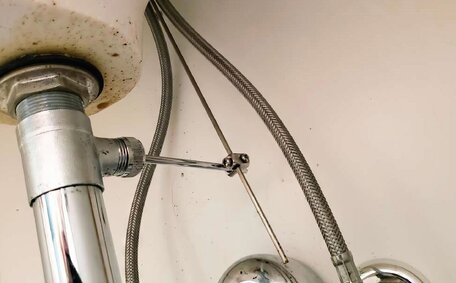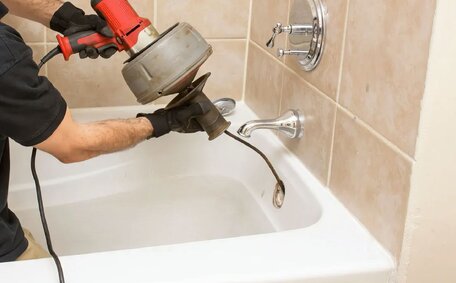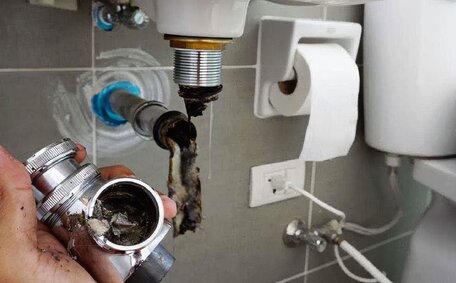Common causes of low water pressure
Common causes leading to low water pressure in your home include:
- Blocked pipes, contributing to reduced water pressure
- Faulty or improperly fine-tuned pressure regulators, which can reduce water pressure when malfunctioning
- Water leaks decrease pressure by allowing water to escape from the system
- Municipal maintenance work or unexpected network issues impacting your water supply
- Hard water, which can lead to mineral deposits and sediment build up inside your pipes
- Undersized pipes that cannot provide sufficient water flow
- Operating various appliances simultaneously, which increase water usage in your household like your washing machine, can strain the system and diminish water flow, a scenario that may necessitate measures to increase water pressure in other areas
- Defective pressure boosters can lead to inconsistent water flow
Common issues like your low hot water pressure may emerge in the hot water systems. Pinpointing low hot water pressure issues requires a systematic examination of the hot water system components.
How to check for issues with fixtures
For homeowners with low water pressure, inspecting fixtures like faucets, taps, and showerheads involves:
- Remove the fixture’s aerator or shower head and check for blockages - remove any debris, sediment, or mineral deposits.
- Inspect and repair or replace fixture valves and handles if they show wear or damage.
- Inspect supply lines and fittings for kinks, crushing, or leaks that can restrict water flow, and replace damaged components to improve efficiency.
- Measure the water flow rate at various temperature settings to isolate fixture-specific pressure issues.
- Ensure taps and showers valves are fully operational, consulting manufacturer guides for adjustments.
- Evaluate whether old fixtures with flow restrictors require cleaning or replacement to prevent blockages.
- Check if all your fixtures run low or it’s an isolated issue directing you to the likely problem source.
Cleaning aerators and showerheads regularly prevents mineral build-up that can lead to low water pressure.
Cleaning aerators and showerheads
Routine cleaning of components such as aerators and showerheads can avert mineral accretion that hampers water pressure house dynamics. Here’s how to clean them:
- Unscrew the aerator or showerhead where the water comes out from the faucet or pipe using a wrench or pliers.
- Use a small brush like an old toothbrush to gently scrub the screen and nozzle holes under running water to remove sediment and debris.
- For extra grime, soak the parts in white vinegar overnight then rinse.
- Replace any worn washers or O-rings.
- Screw the cleaned parts back into place hand tight.
- Briefly run the water to flush out any loose particles.
Regular fixture cleaning every few months helps prevent clogs and maintains pressure.
Inspecting pipes and valves
Thorough inspection of water pipes and valves for potential leaks is vital in pinpointing the cause of low water pressure:
- Locate your water meter’s main shut off water supply valve, commonly referred to as the water shutoff valve, typically situated close to your home’s front external wall. Make sure the stop tap near the front garden is fully open.
- Check for wear, damage, or blockages and contact a local plumber to address any leaks or issues found.
- Pinpoint all isolation and shutoff valves associated with pressure regulation. Test water flow and manage your pressure through your valves with them fully open and closed.
- Enlist a licensed plumber to carry out a water pressure test and to use a pipe inspection camera for in-depth analysis of your home’s water pressure and pipe condition.
- Evaluate the capacity, age and material of pipes to handle current water demand. Seek advice about your potential upgrades like repiping if pipes are undersized.
- Verify that outdoor taps and pools/spas are on distinct branch lines, ensuring they don’t disrupt the water volume inside your residence.
- Ponder scheduling a WaterSafe assessment to engage with your local water services and document any shortcomings for insurance claims.
Inspecting your water main and plumbing systems is essential for solving water pressure issues.
Adjusting the pressure regulator
Locate the water pressure regulator, typically situated near the water line’s entry point into your home. Prior to adjusting the pressure regulator:
- Check your regulator type and get manufacturer guidance on safe adjustment ranges to avoid damage.
- Measure baseline water pressure with a test at fixtures when the system is unstressed.
- Turn the adjustment screw clockwise to raise the water pressure setting, being careful not to reach high water pressure levels, in small increments.
- Retest the pressure and stop once you reach the recommended range.
Incorrect regulator adjustments can reduce system efficiency and lead to problems. In most cases, Engage a local plumber to assess or replace your regulator if you’re unsure about adjustments.
When to call a professional plumber
It’s fitting to call professional plumbers in scenarios like:
- Even after thorough investigation, if low water pressure persists
- The main water supply line or associated shutoff valve needs repairing
- Significant pipe harm or a compromise in your system, which affects your entire plumbing requiring a fix for low pressure, identified within walls or beneath floors
- Complete drain flushes or pipe augering might need to be considered to clear blockages
- Contemplating installations such as a water pressure booster pump, pressure tank, or undertaking repiping
- Pinpointing causes such as a faulty water heater requires specialist tools like a pressure gauge or pipe cameras
- The city water supply or meter connection might be a contributing factor and requires an inspection
Our team at Sans Souci Plumbing has the expertise that can help diagnose tricky low pressure issues, and recommend and undertake appropriate repairs or system upgrades where required.
Repiping or replacing pipes
Corroded galvanised pipes restrict flow; replacing them with copper or PEX pipes improves volume and pressure.
Replumbing your water supply system is substantial work, often involving considerable construction. When it’s time for specialist intervention, entrust an adept team like Sans Souci Plumbing to manage this and ensure:
- Determine if repiping is necessary, especially when water pressure drops below 40 psi (about 280 kPa)
- Manage the safe removal and disposal of old pipes
- Design an efficient new piping layout suited to your home’s specific needs
- Install water supply systems using modern, resilient piping that complies with regulations
- Guarantee a high flow rate across all taps, measurable in litres per minute
With their years of experience, Sans Souci Plumbing can assess the need for repiping to correct low water pressure and provide professional, efficient service.
Leak detection services
Fixing leaks is crucial as they compromise the water supply and pressure in your home’s system. Small leaks can lead to considerable water loss and reduced supply to fixtures.
Sans Souci Plumbing, with a legacy that dates to when your neighborhood was built, provides expert leak detection services to locate any leaks in your plumbing, internally and externally. This can involve:
- Conducting thorough inspections to uncover any leaks your property may have within its piping system
- Employing advanced tools such as acoustic listening devices to locate concealed pipe leaks
- Pressure testing systems to detect any reductions that could suggest leaks on your property
- Using smart water metres for a precise meter reading to analyse unusual usage patterns
- Identifying leak locations for targeted repairs
- Providing permanent pipe repairs, replacements or repiping if leaks are widespread
Identifying and repairing leaks is crucial to resolve low water pressure and return it to optimal levels, and our team is equipped to help. Reach out to our team regarding leak detection services if low pressure lingers after addressing prevalent concerns.






